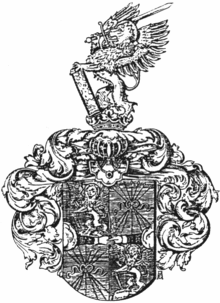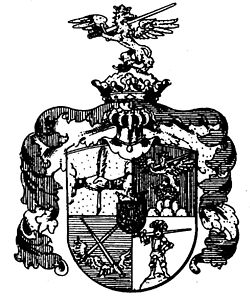Brotherhood of Saint Mark
This article includes a list of generalreferences,butit lacks sufficient correspondinginline citations.(December 2018) |
TheBrotherhood of Saint Mark(German:Marxbrüder,Marx brothers) was the name of the most important organization ofGerman swordsmenin the 16th century.


History[edit]
The brotherhood originated in the 15th century, but it is not known when exactly it was founded.Hans Talhoffermay have been an early member, or even one of the founders (thelion of St Markappears in his coat of arms in a manuscript of 1459). The earliest certain attestation dates to 1474. The group held an annual meeting inFrankfurt,where they elected theircaptain(Hauptmann). In 1487,Frederick IIIgranted them the monopoly on the title "master of thelong sword"(Meister des langen Schwerts), effectively making them a fencers'guild.This title was relevant for theLandsknechts,because a certified "master of the long sword" wielding theZweihänderwas entitled to twice the pay of a normal soldier (Doppelsöldner).
The earliest reference to the brotherhood calls them the brotherhood of Our dear lady and pure Virgin Mary and the Holy and warlike heavenly prince Saint Mark (German:bruderschafft Unserere lieben frawen und der reynen Jungfrawen Marien vnd des Heiligen vnd gewaltsamen Hyemelfursten sanct Marcen). After their recognition by Frederick, the brotherhood was usually referred to as "Marxbrüder", "Bruderschaft des heiligen Marren" or "Bruderschaft des St. Markus" ( "Marx brothers", "Brotherhood of St. Mark" ).
Anton Rast (captain in 1522) was a known member of the brotherhood.[citation needed]Woodcuts,some of them byAlbrecht Dürer,and other references, show that more than justrapieruse was taught by the Marxbrüder. They also taught the use of the Zweihänder (as mentioned above), thedussack,thespear,thequarterstaffand thelongsword.The dussack, being primarily a practice weapon, was used to train the real-life use of single-edged swords like thelanges Messer.
A second fencing brotherhood, theFederfechter,was founded inPraguein 1570, and recognized by the city ofFrankfurt,in spite of protests by the Marx brothers, in 1575. From 1607 the two societies shared equal privileges, as in that year, the Federfechter received their first letter of privilege fromRudolph II,theHoly Roman Emperor.
A third guild may have beenLukasbrüder(brotherhood ofSaint Luke). They had no official recognition, however, and were probably closer to a society ofhooligansthan to a proper guild.
Important centers of16th century martial artsin Germany wereFrankfurt,AugsburgandNuremberg.
See also[edit]
External links[edit]
- http:// swordhistory /excerpts/marx.html
- http://jan.ucc.nau.edu/~wew/fencing/german.html
- https://web.archive.org/web/20050412012652/http:// georgehernandez /xMartialArts/Blades/SwordHistory.htm
- https://web.archive.org/web/20091229123531/http:// marxbruder /
References[edit]
- Secret History of the Sword,by J Christopher Amberger
- Schools and Masters of Fence,by Edgerton Castle
- The History of Fencing: Foundations of Modern European Swordplay,by William Gaugler
